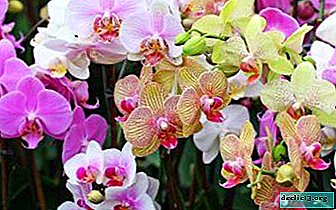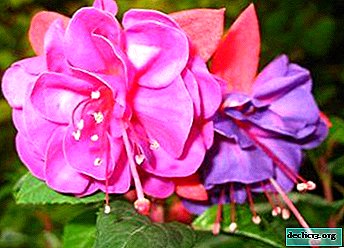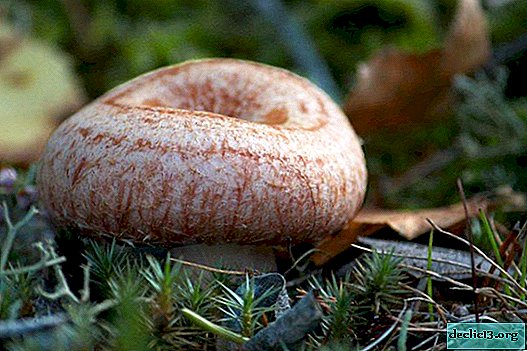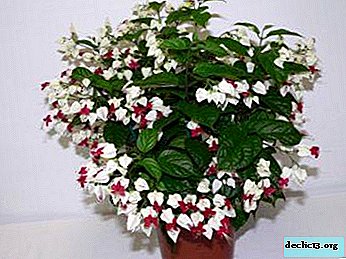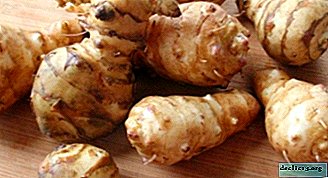The tropical cactus in your home is ripsalidopsis. Description of the flower, its types and features of care
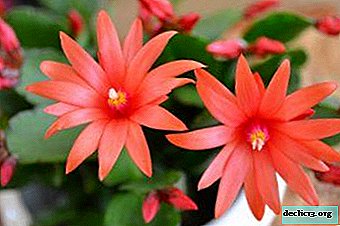 Ripsalidopsis is an elegant exotic plant. It is part of the Cactus family, but significantly different from the "classic" brothers. Grows in tropical rainforests, has bright flowers and succulent leaves. In the usual conditions for ordinary cacti (drought and the scorching sun) ripsalidopsis quickly die. In this article, we learn about the differences between ripsalidopsis and Schlumbergera, the main types of plants, care, reproduction, flowering characteristics and the most common pests.
Ripsalidopsis is an elegant exotic plant. It is part of the Cactus family, but significantly different from the "classic" brothers. Grows in tropical rainforests, has bright flowers and succulent leaves. In the usual conditions for ordinary cacti (drought and the scorching sun) ripsalidopsis quickly die. In this article, we learn about the differences between ripsalidopsis and Schlumbergera, the main types of plants, care, reproduction, flowering characteristics and the most common pests.
Botanical Description
Ripsalidopsis is a small evergreen shrub. Refers to epiphytes: in natural conditions for growth it is attached to another plant and uses it as a support, is not a parasite. The average height of the bush is 30 cm. The stems consist of segments (length - 5 cm, width - 3 cm), their color is pale green. When exposed to the sun for a long time, the segments turn red. Excerpts from the botanical description.
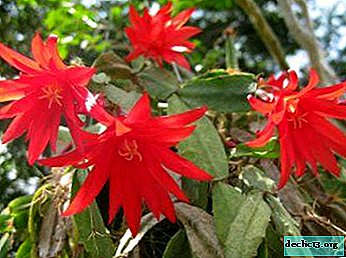 The stalk is fleshy, a leaf in the form of a wide plate. This allows you to retain moisture and nutrients.
The stalk is fleshy, a leaf in the form of a wide plate. This allows you to retain moisture and nutrients.- There are protrusions along the edges of the segments, spines in the form of thick bristles at the ends.
- Flowers bloom at the ends of the segments. From one areola, 1-3 flowers appear, they are wide open, reach 4 cm in diameter.
- After flowering, small berries appear.
There are no fascinating legends about the history of ripsalidopsis. It is known that this plant was first discovered in the tropics of Brazil (South America). Modern taxonomy has excluded the genus Rhipsalidopsis from the list; all plants from this species have been transferred to the genus Hatior. Therefore, in flower shops you can find this variety of cacti under a different name. The habitat geography covers mainly the forests of South America, some of the subspecies are found in North America, Africa and Sri Lanka. The plant settles in unusual places:
- ledges of trees;
- hollow;
- cleft trunks;
- kick.
Despite its appearance, ripsalidopsis is a cactus. The plant has a number of other names. Usually it is called forest or wood cactus. Another option is an Easter cactus or an Easter candle. The explanation for this is simple: the color begins in the spring, by Easter.
Unlike Schlumberger
Ripsalidopsis has a double. This is Schlumberger or Zygocactus, popularly known as the Decembrist. You can distinguish these plants by some features.
| Ripsalidopsis | Schlumberger | |
| Segments | The protrusions are smooth and invisible | Sharp teeth protrusions |
| Flower | Radial symmetry, flat whisk | Corollas are clearly beveled |
| Flowering period | Spring | Winter |
Read more about the differences between ripsalidopsis and Schlumbergera here.
The main types and their photos
The type of ripsalidopsis is further divided into subspecies. Breeders bred many varieties.
Gartner

The height of the bush is 20 cm, the stems are flat, hanging. This variety is most often grown in hanging pots, baskets.
Pink

Length - 25-30 cm. Feature - delicate flowering. The shape of the flowers is star-shaped, the color is pink, in the middle there is a bright yellow splash.
Andromeda

Andromeda's flowers are maroon6 cm in diameter, orange cores.
Care
The following are the main components of caring for rispalidopsis at home.
| Factor | Explanation |
| Where to put a pot or planter? | In the summer in the fresh air, far from the draft and the sun (under a tree). In winter, the north-east or north-west side of the room. |
| Shine | Enough diffused, but bright lighting. The plant tolerates partial shade, but it does not bloom. |
| Temperature | Performance varies by season and condition.
|
| Humidity, watering. | Minimum - 60%.
|
| Soil substrate | It requires loose, rough soil. Peat mix, sheet land, perlite or coarse river sand are suitable. |
| Transfer | Spend after flowering, i.e. at the beginning of summer. |
| Top dressing | Contribute during the period of active growth at least 2 times a month. It is optimal to take the mineral complex specifically for cacti. Organics are prohibited. |
About growing ripsalidopsis at home and in the open ground can be found here.
How does reproduction occur?
Cactus can be propagated by 3 main methods. Each of the options has its own specifics.
- Stem cuttings. Segments from the stem are separated by smooth rotational movements. 2-3 segment segments are required. Then they are dried for 2-3 days. Then put vertically on moistened soil, be sure to lean against the support. Do not bury.
- Vaccination on the stem of the Peresius prickly (leaf cactus). Spend in the summer. At the pereskia, a bare stem is left, slightly split above. 2-3 segments are cut from ripsalidopsis, sharpened and inserted into the cleavage. The vaccine must be fixed with a needle or spike, wrap with a band-aid. Coalescence occurs on average after 14 days.
- Seeds. To get you need to take 2 adult cactus of different varieties. From one instance, gently with a brush, you need to take pollen and transfer to another. After flowering, the fruit will remain in the form of a red berry. It must be left to ripen. Tearing off when he wrinkled.
Flowering features
With optimal care, ripsalidopsis will bloom in early spring (March). The duration of flowering is 1.5-2 months. Flowers have a different color: pink, white, red. The palette of tones is small, but the flowers are bright and juicy.
To learn more about flowering ripsalidopsis and caring for it during flowering, watch the video:
Diseases and Pests
The cactus is susceptible to disease, and parasites can also attack it. What problems are possible?
- Gray rot. Gray-beige weeping spots appear on the stem, with time an ashy “pile” and black dots appear on them.
- Root rot. The base of the stem turns black, it is slimy to the touch.
- Late blight. Slowing growth, loss of elasticity by segments. The stalk fades, becomes covered with vague brown spots.
- Mealybug. Signs of an attack are a white coating on the green mass, which looks like lumps of cotton wool. The buds and stems are deformed, discolored, and dry.
- Shield. A beige or brown-gray growth appears on the stem. At first it is flat, with time it swells. The tissue around the growth turns yellow, the soil in the pot turns black.
Similar plants
 Ripsalidopsis-like flowers are included in the subspecies of forest cacti. All of them have fleshy stems, a similar structure and require the same conditions of detention. Among similar epiphyllum. It has a leafy stem of dark green color. Flowers in diameter reach 12 cm, the colors are bright, the fragrance is fragrant. What other flowers are similar?
Ripsalidopsis-like flowers are included in the subspecies of forest cacti. All of them have fleshy stems, a similar structure and require the same conditions of detention. Among similar epiphyllum. It has a leafy stem of dark green color. Flowers in diameter reach 12 cm, the colors are bright, the fragrance is fragrant. What other flowers are similar?
- Ripsalis. It is a dense shrub that has many thin stems. At the ends of the shoots are small buds of yellow hues.
- Prickly pear. The thick and flat segments form one trunk. It has an abundance of thorns. Also on the main stem there are processes and flowers of various shades.
- Pereskia. Ancient succulent. The leaves are decorative, the stem performs all functions. The fruits are edible.
- Scaly cactus. Has elongated stems, buds are formed around the edges. Bright flowers and fruits.
So, ripsalidopsis is a great option for growing a house. Long stems will look advantageous in a hanging planter, and bright flowers will please the eye and fill the room with a pleasant aroma.

 The stalk is fleshy, a leaf in the form of a wide plate. This allows you to retain moisture and nutrients.
The stalk is fleshy, a leaf in the form of a wide plate. This allows you to retain moisture and nutrients.